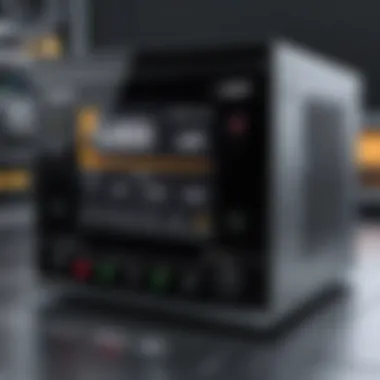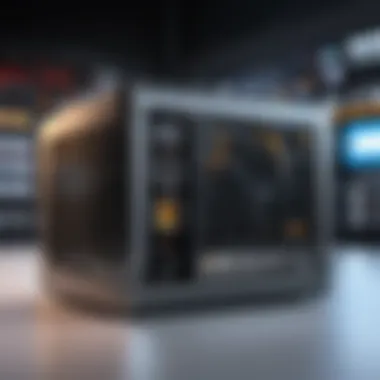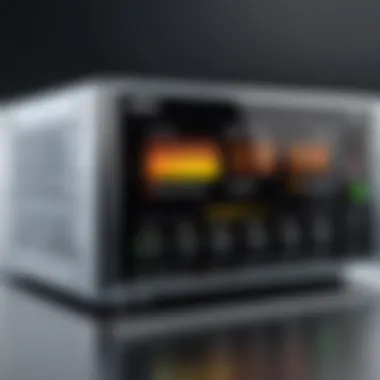Understanding 500 Watt Power Supply Units: A Detailed Guide


Intro
In the evolving realm of computer hardware, the choice of power supply units remains a critical factor for ensuring system performance and stability. As computing demands grow, enthusiasts, gamers, and IT professionals face the challenge of selecting the right power supply to accommodate powerful components without compromise. The 500 watt power supply unit strikes a balance by providing ample power for various configurations, catering to a spectrum of user requirements.
Understanding the significance of these units requires an exploration of their specifications, features, and impact on overall system functioning. From efficiency ratings to compatibility with modern components, each aspect contributes to the ultimate effectiveness of a power supply. This article provides insights dedicated to enriching readers' knowledge base in this essential area of computer hardware, allowing them to make informed choices in their technology investments.
Product Overview
Brand Information
Several reputable brands manufacture 500 watt power supply units. Notable names in this sector include Corsair, EVGA, and Seasonic, among others. Each brand typically offers various models that cater to different needs, ensuring options for both budget-conscious users and those seeking premium performance.
Key Specifications
Key specifications of 500 watt power supply units include:
- Wattage: Typically rated at 500 watts, providing a good balance for various setups.
- Efficiency Rating: Most units boast at least an 80 PLUS certification, ensuring effective energy management and reduced electricity consumption.
- Modularity: Users can find both modular and non-modular options. Modular supplies allow users to connect only necessary cables, which aids in cable management and airflow optimization.
- Connectors: Most have a variety of connectors for GPUs, motherboards, and peripherals, which enhances compatibility with system components.
Pricing
The pricing of 500 watt power supply units can vary significantly based on brand, features, and efficiency ratings. Generally, the costs range from approximately $50 to $110. Premium models might be priced higher but often offer enhanced reliability and better customer support through warranties.
Performance Comparison
Benchmark Tests
Testing the performance of power supply units often occurs under varying loads to evaluate their stability and voltage regulation. A respected tool for such tests is the
Prologue to Power Supply Units
Power Supply Units (PSUs) are crucial components in computers and various electronics, converting AC power from outlets into the DC power required for system components. Knowing how PSUs function and their role is fundamental for anyone involved in computer hardware, particularly in the gaming and IT professional fields. This section upholds the foundational knowledge necessary for making informed decisions when selecting components like the 500-watt power supplies.
Definition and Functionality
A power supply unit serves to provide electrical energy to other components of a system. Its primary role includes transforming and delivering the power needed to run hardware like the motherboard, CPU, and peripherals. Many may think of PSU solely as a power source, but it plays a larger role in ensuring stability and longevity of the components.
- Voltage Regulation: PSUs stabilize output voltage levels, protecting hardware from fluctuations that can lead to malfunctions.
- Switching Power Supply: Most modern PSUs are switching types; they use complex electronics and transformers to efficiently convert power, minimizing waste and heat generation. This efficiency has significant implications for energy consumption.
In essence, understanding the definitional and functional nuances gives insight into how integral a PSU is to overall system performance.
Overview of Wattage Ratings
Wattage ratings describe the maximum amount of power a PSU can deliver continuously. When referring to a 500-watt power supply, it means the unit can handle up to 500 watts of electrical load on a sustained basis. However, effective use not only requires awareness of wattage but also understanding how it correlates with total system requirements.
Relevance to Users:
Many end-users confuse raw wattage with actual requirement calculations. Thus, knowing just the wattage might lead to discrepancies in power allocation leading to system instability or component underperformance.
Moreover, calculations include components like:
- **Motherboards
- Processors
- Graphics Cards
- Drives (HDD/SSD)
Taking the time to analyze total system wattage needs enables better performance insights and potential savings, articulating why accurate wattage comprehension is imperative.
The Importance of a Watt Power Supply
The significance of a 500 watt power supply in computing cannot be overstated. This power unit serves as the heart of a computer system, supplying the necessary voltage and current to the various components. Many factors drive its importance, particularly its suitability for gaming systems and versatility for general applications. An understanding of these aspects can lead users to informed decisions, optimizing their tech investments.
Suitability for Gaming Systems
Power Requirements of Gaming Components
Gaming systems often rely on high-performance components like graphics cards, CPUs, and cooling systems. The power requirements of these components are substantial and vary by the specific hardware deployed. For instance, demanding graphics cards from manufacturers like NVIDIA or AMD can require considerable power to deliver peak performance.
A 500 watt unit usually meets the basic power requirements for mid-range gaming rigs. It offers a stable voltage, which is crucial when pushing components to their limits during high-intensity sessions. Crucially, it ensures that users can expect adequate power distribution, enabling smoother gameplay experiences with fewer performance issues.
However, it is essential to consider that as gaming needs evolve with new titles requiring more robust specifications, a lower-rated power supply may become a bottleneck. Understanding specific component requirements beforehand can guide purchasing choices effectively.
Impact on Performance


The impact that a power supply unit has on overall system performance cannot be downplayed. A reliable 500 watt power supply can enhance gaming experience in multiple ways. A stable power supply prevents voltage fluctuations, which can hamper a system during critical gameplay moments, reducing potential lag.
Furthermore, quality power supplies often exhibit better load distribution capabilities. When effectively managing power, performance discrepancies are less likely. A significant feature about power supplies is their efficiency at varying loads. This trending aspect impacts not only performance but enhances component lifespan, saving in replacements and upgrades over time. As such, investing in an efficient power supply unit becomes beneficial for dedicated gamers.
Versatility for General Use
Office vs.
Gaming Builds
While 500 watt power supplies cater primarily to gamers, their versatility appeals to general users as well. The balanced wattage rating provides sufficient power for regular office tasks while permitting potential upgradability for future gaming needs. Components assembled in a typical office build do not demand the same wattage as high-end gaming rigs, but ensuring capability for growth can aid future-proofing strategies.
The key characteristic of this power rating is adaptability. It can transition gracefully from ordinary workloads to gaming setups without necessitating immediate replacement or upgrades. Such users appreciate investing in a power supply that is not only powerful yet practical.
Energy Efficiency Considerations
Energy efficiency in a power supply holds significant merit. It translates to reduced electricity consumption, thus saving costs over time, key for both gamers and general users. Those using a 500 watt power supply can expect it to be more efficient with the 80 Plus certification being a profound emphasize, indicating superior energy conversion capabilities.
Efficient designs minimize wasted energy, thus reducing heat production. This characteristic ensures that the system can maintain cooler operational or well, addressing reliability factors effectively. The right choice reflects responsibly on one’s environmental impact and influences utility costs.
Key Features of Watt Power Supplies
Understanding the key features of 500 watt power supply units helps to appreciate their role in computing systems. Power supply units are essential for delivering the needed power and maintaining the stability of computer systems. In a 500 watt unit, users can expect specific traits that are important for performance and reliability. This section will cover efficiency ratings, design types, and cooling solutions.
Efficiency Ratings
Plus Certification
The 80 Plus certification signifies that a power supply unit delivers at least 80% efficiency at normal loads. Its significance extends to both performance and cost savings. Users often choose units with this certification because they waste less energy compared to non-certified options. This means lower power bills over time.
A key characteristic of the 80 Plus program is the tier system that categorizes power supplies from Basic to Platinum levels. Each level represents energy efficiency incrementally. Power supplies like the EVGA 500 W1, Bronze and others showcase these certifications. Such certifications bring peace of mind about energy usage.
Importance of Efficiency
Efficiency in a power supply unit is crucial because it directly influences the overall energy consumption of a system. Higher efficiency means less energy lost as heat, which is often converted into noise. This reduction in waste encourages a quieter operation. Additionally, an efficient unit leads to longer life spans. Components do not bear the stress of overworking, avoiding premature failures and ultimately enhancing reliability in performance.
Efficiency affects other elements too, notably cooling requirements. Less heat automatically reduces the burden regarding thermal management, allowing for a more simplified cooling system down the line.
Modular vs.
Non-Modular Designs
Advantages of Modular Power Supplies
Modular power supplies allow users to connect only the necessary cables needed for their systems. This modularity prevents clutter and purportedly leads to improved airflow. Users appreciate these units because they can customize their setups based on requirements.
One of the most beneficial attributes is the ability to change cables over time. If technology evolves, power requirements change; with a modular unit, individual cables can be replaced without necessary disruption to the complication of system builds. Brands like Corsair often make units that allow versatility with modular designs.
Disadvantages of Non-Modular Designs
Non-modular supplies have all cables permanently attached. This design can lead to excess wiring inside the case, making for air circulation issues and potentially holding others back from getting the desired airflow.
Though these types tend to be more budget-friendly, their construction might cause problems with maintenance. Replacing components or tech upgrades become more time-consuming. This may affect gamers, who regularly switch parts for optimal performance. Therefore, weighing the pros and cons, many users might lean towards modular supplies for clearer setups.
Cooling Solutions
Types of Cooling Methods
Cooling methods in power supply units come in crucial for their effective performance and preventing overheating. There are largely three methods: convection cooling, active cooling with fans, and hybrid solutions.
- Convection cooling relies on heat dissipation through materials without fans. This impractical method can work for compact, low-power systems, but not for high-performance models.
- Active cooling employs fans, helping to expel heated air. Noise becomes an element here, as the spinning components can disturb quiet environments, such as gaming rooms. Users often seek larger fans running at lower speeds because they minimize noise and pressure more than smaller ones done more quickly.
Effect on Longevity
Cooling methods directly relate to the longevity of power supply units. Poor cooling design potentially shortens lifespan due to overheating. It often results in burnt-out components that require replacements, thereby increasing the long-term cost of ownership.
On the contrary, quality cooling methods enhance not just the performance but overall reliability. Efficient designs lead to stable supply during manager intensive tasks like gaming and video processing. As a result, choosing the right cooling methods helps in maintaining power supply youth in heavy-use conditions.
A well-designed power supply unit provides efficiency, modular design, and adequate cooling solutions, which are not just nice-to-haves but necessities in enhancing overall computing performance.


Compatibility Aspects
Compatibility within computing systems is a critical factor when selecting a power supply unit. A 500 watt power supply directly interacts with various system components. Understanding compatibility ensures stable performance and prevents hardware failures. Overall, it leads to more satisfaction from your build.
Motherboard and CPU Compatibility
Understanding Connectors
Connectors are essential in ensuring that the power supply unit fits and functions well with your motherboard and CPU. Proper connectors ensure a seamless flow of power to the various components. Common connectors include ATX for the motherboard, PCIe for graphics cards, and SATA for drives.
The primary reason why connectors are a beneficial choice is their standardization. Most modern power supplies come equipped with the necessary connectors to suit various system designs. A unique feature of these connectors is their varying pin configurations, making them tailored for specific components which enhance optimal performance.
However, having the wrong type of connector can lead to inadequate power delivery or even system failure. Ensuring compatibility in connectors is essential for the overall performance of your system.
Power Distribution
The essence of Power Distribution lies in how effectively the power supply distributes voltage and current among the components. Efficient power distribution is crucial for performance and reliability in high-demand scenarios.
A key characteristic is the balanced distribution of power across rails. This balance leads to improved stability during operation. Furthermore, many 500 watt power supplies use multiple +12V rails to enhance the distribution. This method lowers the risk of overheating and protects your components better than a single rail approach.
Nevertheless, it’s important to monitor the demands of your components. If a power supply cannot distribute power effectively, you may face performance issues or erratic behavior with your rig.
Graphics Card Considerations
Power Requirements of GPUs
The Power Requirements of Graphics Processing Units (GPUs) play a vital role in the overall functionality of a system. Modern GPUs often have significant power requirements due to their complex architecture and performance needs.
The notable feature of GPUs is their surge in power requirements during demanding operations, such as gaming or video rendering. Having sufficient power supplied ensures that performance maintains levels needed to avoid crashes or graphics hiccups.
Lack of adequate power for a GPU risks system instability and can even limit overall performance. Therefore, attention to wattage is a critical factor for any tech mineral.
Potential Bottlenecks
Understanding Potential Bottlenecks involves recognizing points where power distribution fails to fulfill the system’s needs. These bottlenecks can lead to degraded performance. Sometimes, underpowered components can cost significant frustration especially while gaming or executing intensive tasks.
The primary concern extends to graphics compatibility with other components, primarily when various hardware technologies demand high wattage. Although in a well-balanced system, no specific component underperforms, it is important to monitor power draw to prevent undue stress on the power supply.
Safety and Certifications
Safety and certifications for power supply units are critical aspects to consider when selecting a 500 Watt Power Supply. A power supply that meets high safety and quality standards not only protects the components within a system but also enhances overall reliability. When evaluating power supplies, understanding the certifications and safety features can help ensure a well-protected system that operates efficiently.
Importance of Safety Standards
Electrical Safety Certifications
Electrical safety certifications are necessary for guaranteeing that a power supply operates safely. These certifications are often granted by respected organizations like UL, CE, and FCC. An important characteristic is that these safety standards confirm products were tested under various conditions to protect users. By ensuring the security of the power supply, these certifications build trust among consumers.
The advantage of electrical certifications is that they help reduce the risk of hardware failure due to power-related issues. It is not rare to see budget or lesser-known products labeled without these certifications. However, using certified power supplies can mitigate risks and provide peace of mind, especially in high-performance systems.
Protection Mechanisms
Protection mechanisms act as crucial safeguards within power supply units, ensuring both safety and performance. Common features include over-voltage protection, under-voltage protection, and short circuit protection. Technically, these systems are designed to monitor the output voltage and current levels constantly and shut down the unit if any parameter exceeds safe limits. The key characteristic here is adaptability to different power conditions, which minimizes the risk of damage.
One unique value of implementing robust protection mechanisms is its role in significantly prolonging the lifespan of connected components. It acts prevent heated conditions which may hurt hardware and disrupt functionality. Though some low-budget alternatives lack sufficient protection features, it is a must-have element in power supplies, especially for those handling potent hardware and modes of operation.
Risks of Subpar Power Supplies
Potential Damage to Components
Subpar power supplies can result in significant damage to computer components. A critical aspect to recognize is how inadequate power supplies often deliver unstable power. Consequently, this inconsistency can lead to failures and even catastrophic damage to critical elements like motherboards and graphic cards.
Most importantly, the longevity of systems significantly shoes the commencing weaknesses of low-quality power units. When power supplies fail to provide optimal power output, other components suffer from stress-caused behavior, leading to intermittent problems. Using quality power supplies with the right certifications greatly reduces this risk. Clients should always assess the reliability and brand reputation to counteract unreputable sources.
Fire Hazards
Fire hazards can arise from poorly designed or low-quality power supplies. These hazards are predominantly due to overheating caused by insufficient thermal management. An important qualitative aspect is ensuring that complementary components such as cable management and heat dissipation fans work adequately.
A significant drawback comes from generic power supplies often equipped with inadequate cooling solutions; this amplifies overheating risks producing potentially disastrous effects within computing systems. This is particularly considering the essential and high-powered components rely heavily upon interlink integrity and device performance. Hence, ensuring quality designs is critical to minimizing such risks, fostering safer systems for users.


Choosing the Right Watt Power Supply
Choosing the correct 500 watt power supply unit is pivotal in optimizing your computing needs. This selection directly impacts system stability, performance, and overall efficiency. With the multitude of available options, users must investigate beyond surface specifications to ensure they find a suitable power supply that meets their specific requirements. It’s much more than just delivering power; it’s about building a robust architecture to support your hardware.
Assessing Your Needs
Identifying Total System Power Usage
When determining the correct power supply, a foremost step involves identifying total system power usage. This process entails calculating the power requirements of each component in your setup. By understanding component wattage, you carefully select a power supply that adequately meets or exceeds total needs.
Key characteristics here include knowing how much power your CPU, GPU, and additional devices demand. Many enthusiasts find this step vital: an undersized power supply can lead to system instability, especially during peak demand.
Each component typically lists its power requirements on the manufacturer’s website or within specifications booklet, making this identification straightforward. However, keeping track of this necessitates an astute understanding of each element within your configuration.
Although calculating power usage might seem tedious, the process offers benefits, including:
- Enhanced stability
- Ability to support future hardware upgrades
- Prevention of overheating and potential burnout
Any individual aiming for a future-proof and efficient developt doesn’t want to overlook this significant factor.
Future-Proofing Your Setup
Future-proofing your setup is essential in a rapidly advancing tech landscape. Choosing a 500 watt power supply with added capacity allows for potential upgrades in components without the need.Bias against the issue, it can safeguard against financial drain in the long run.
One key characteristic involves selecting a power supply that exceeds your immediate needs, factoring in adequate headroom for future upgrades. This choice can save you trouble later on when advances in graphics or processing power mandate quick upgrades.
The additional capacity ensures that energy flow sustains comfort even when newer components demanding higher wattages emerge. As technologies evolve, having that flexibility allows your system to perform without unnecessarily frequent updates.
Understandably, a power supply that is slightly more potent may entail a small additional upfront cost, but experience suggests this prudent investment pays dividends over time by mitigating unexpected requirements when updating with burgeoning new hardware.
Evaluating Brands and Models
Selecting a reputable brand and specific model enhances confidence in your unit’s reliability. Not all power supplies promise equality in performance or reliability; hence, overwhelming popularity doesn't always translate into value.
Comparison of Popular Brands
When discussing power supplies, a fundamental aspect lies in the comparison of popular brands available today. Many manufacturers, including Seasonic, Corsair, and EVGA, dominate the market. Each company embodies its design philosophies, which can significantly impact reliability and overall user experience.
The various options foster a natural climate for product scrutiny. For example, Corsair often excels in efficiency ratings, while Seasonic frequently garners praise for overall build quality. Thus, evaluating these brands arms buyers with the knowledge to steer clear of poorly constructed units, ensuring satisfaction.
The comparative advantages include but are not restricted to:
- Industry reputation
- Warranty offerings
- User feedback on performance, quantifying expected longevity for future maintenance
It remains essential for the astute buyer to research thoroughly when pinpointing a brand already well regarded within technical communities.
User Reviews and Reliability
User insights reflect fields often hidden behind package — reassessing user reviews and reliability becomes quintessential for confident purchasing. Understanding practical evaluations sharpens insight into tangible performance amidst voluminous claims by manufacturers.
By reviewing varied user experiences, understanding potential drawbacks emerges. Highlights from widespread feedback often correlate with trends in both durability and shortcomings that weren’t necessarily self-evident from official listings.
Different unique features often surface through collective feedback, shaping potential consively inquiries. Attention to:
- Patterns seen regarding customer service responsiveness
- Instances of failure for specifics models
- Temperature stability during heavy intervals of usage
Overall, comprehensive reviews contribute a pivotal driving force when addressing reliability for any potential unit. Gathered insights can be distinguished from manufacturer rhetoric.
As you explore your options, remember a thorough investigative approach to selecting a power supply ultimately yields a victorious selection outcome for your unique set of demands.
Epilogue
The conclusion section wraps up the extensive discussion about 500 watt power supply units. It serves an essential role by synthesizing the crucial insights and emphasizing the key takeaways from this exploration. An effective conclusion not only provides readers with a recap but also highlights the implications for selecting the right power supply for specific use cases.
Understanding and choosing a suitable power supply requires careful consideration of several elements. These include efficiency ratings, compatibility with system components, and safety certifications. The importance of a 500 watt unit lies in its ability to balance the demand of various computer parts while ensuring smooth operation. It is wise to factor in future upgrades to maximize value.
Summary of Key Points
In this in-depth analysis, we covered:
- The critical function of power supplies in providing stable and adequate power.
- Key features of 500 watt power supply units, including efficiency ratings and modal design options.
- Compatibility aspects that affect the overall performance of a computing system.
- Safety measures and potential risks of using unreliable units.
This detailed reflections show how significant power supply units are in ensuring a resilient and effective computing experience.
Final Recommendations
When embarking upon the purchasing journey, review your requirements thoroughly. Assess not just the immediate needs but also take a proactive approach to accommodate future expansions. Consider high-reputation brands recognized for reliability, such as Corsair, EVGA, and Seasonic. User reviews can provide invaluable insights into performance and durability for better decision making. Take time to weigh all factors mentioned, as this informs not just an efficient setup but one that maximizes stability and safety too.
Choosing wisely protects your investment in tech and ensures longevity in your setup.
The ultimate goal is to attain a well-balanced computer system that can handle the payload of demanding hardware, particularly in gaming and high-performance applications.







